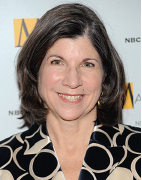Anna Quindlen, Evan’s Two Moms

Anna Quindlen was born in Philadelphia and graduated from Barnard College in 1974. She worked until 1994 for the New York Times, writing the “About New York” column and then two syndicated columns: “Life in the 30s,” which drew on her experiences with her family and neighborhood, and “Public and Private,” which explored political issues. She was a contributing editor and columnist for Newsweek from 2000 to 2009. Quindlen won the Pulitzer Prize for Commentary in 1992, and many of her columns have been collected in the books Living Out Loud (1986), Thinking Out Loud (1993), and Loud and Clear (2005). Quindlen also has written seven novels — most recently, Every Last One (2011) and Lots of Candles, Plenty of Cake (2012) — as well as the advice books A Short Guide to a Happy Life (2000) and Being Perfect (2005). In “Evan’s Two Moms,” written in 1992, Quindlen emphatically argues that gay marriages should be legalized.
AS YOU READ: Identify the main points Quindlen uses to support her position.
1
Evan has two moms. This is no big thing. Evan has always had two moms — in his school file, on his emergency forms, with his friends. “Ooooh, Evan, you’re lucky,” they sometimes say. “You have two moms.” It sounds like a sitcom, but until last week it was emotional truth without legal bulwark.° That was when a judge in New York approved the adoption of a six-year-old boy by his biological mother’s lesbian partner. Evan. Evan’s mom. Evan’s other mom. A kid, a psychologist, a pediatrician. A family.
2
The matter of Evan’s two moms is one in a series of events over the last year that lead to certain conclusions. A Minnesota appeals court granted guardianship of a woman left a quadriplegic in a car accident to her lesbian lover, the culmination of a seven-year battle in which the injured woman’s parents did everything possible to negate the partnership between the two. A lawyer in Georgia had her job offer withdrawn after the state attorney general found out that she and her lesbian lover were planning a marriage ceremony; she’s brought suit. The computer company Lotus announced that the gay partners of employees would be eligible for the same benefits as spouses.
3
Add to these public events the private struggles, the couples who go from lawyer to lawyer to approximate legal protections their straight counterparts take for granted, the AIDS survivors who find themselves shut out of their partners’ dying days by biological family members and shut out of their apartments by leases with a single name on the dotted line, and one solution is obvious.
4
Gay marriage is a radical notion for straight people and a conservative notion for gay ones. After years of being sledgehammered by society, some gay men and lesbian women are deeply suspicious of participating in an institution that seems to have “straight world” written all over it.
5
But the rads of twenty years ago, straight and gay alike, have other things on their minds today. Family is one, and the linchpin of family has commonly been a loving commitment between two adults. When same-sex couples set out to make that commitment, they discover that they are at a disadvantage: No joint tax returns. No health insurance coverage for an uninsured partner. No survivor’s benefits from Social Security. None of the automatic rights, privileges, and responsibilities society attaches to a marriage contract. In Madison, Wisconsin, a couple who applied at the Y with their kids for a family membership were turned down because both were women. It’s one of those small things that can make you feel small.
6
Some took marriage statutes that refer to “two persons” at their word and applied for a license. The results were court decisions that quoted the Bible and embraced circular argument: marriage is by definition the union of a man and a woman because that is how we’ve defined it.
7
No religion should be forced to marry anyone in violation of its tenets,° although ironically it is now only in religious ceremonies that gay people can marry, performed by clergy who find the blessing of two who love each other no sin. But there is no secular° reason that we should take a patchwork approach of corporate, governmental, and legal steps to guarantee what can be done simply, economically, conclusively, and inclusively with the words “I do.”
8
“Fran and I chose to get married for the same reasons that any two people do,” said the lawyer who was fired in Georgia. “We fell in love; we wanted to spend our lives together.” Pretty simple.
9
Consider the case of Loving v. Virginia, aptly named. At the time, sixteen states had laws that barred interracial marriage, relying on natural law, that amorphous° grab bag for justifying prejudice. Sounding a little like God throwing Adam and Eve out of paradise, the trial judge suspended the one-year sentence of Richard Loving, who was white, and his wife, Mildred, who was black, provided they got out of the State of Virginia.
10
In 1967 the Supreme Court found such laws to be unconstitutional. Only twenty-five years ago and it was a crime for a black woman to marry a white man. Perhaps twenty-five years from now we will find it just as incredible that two people of the same sex were not entitled to legally commit themselves to each other. Love and commitment are rare enough; it seems absurd to thwart them in any guise.
Questions to Start You Thinking
Question
FyPXNkaJNfk8L7RZ+H7OE1BgBnZ6dbu7fzyzCjw9pErzOhn9m1UFIFrQR96kU9GoqaDhd0RTBxLBvxctAc45G19x6W37aGVxoNpF5msuBm0z4lFto3issX3QY7+JRi7otZYQam9sY5nrmpmksMUfup0EtMSpnyagbRvccbnWMLCnxE0P/P4qIMLMWjTn2LoGRJpfG4H/akFWHIjlWCFTXg==Question
w36tgT+jZjolHU4H8ad1B4EUTdz/0c7yOW/JHve4HrI12yFvs5nMv6QaewrnvX2b/+H3AukM7FvYUVwBvUtiJEea0RSH21VOW67uFCgaUWdyu+Af/hhAlvwwuDQNY6s0exy1fJnWU83+fHCeg4EykIzVeMxvO0+kNDnDoPFRaIOq9HDh5HZcFkzqcA3rSEKVciGZ7PCk8uXF3UZ+ROg/EfE9+91YPImHAJqyNjBRVQlIypVUZpZblr3cby3vU8wHntia5ABGQdeV7J50caDigQPkRpCPGIM92mAsaSAHqwllYSvFxi0r5wXv/43IT8hlhl02QsVL5fIf3MEGNCUmD95F78Bzi6h9DpJZ5mtOfDzGq2WHKaX0JyQaFm4=Question
+aI4fQC6W0kTmrFv06MZv60zStD6ebbIkAql88xCGybC9209NjDJ1Hz0RPPjykPtn2XukB8at6Icysj7ban2PO8fdAzUiS3bomK6CEuFP+o3cQ0cvtFyZ3v8BNcD4QUgtPFAYFYOh6h/4T6Jn/fCelhjYWc+BCzZNEOQaNGRA4KHrL8dcXQnGu/Sv5nF94Cy9K2GYRPrL8mFXG5BG7GqrZF9Rj14ffzyxcTfy9BS6GN7SgaukpIJhxBFWk4MdPebq51y7wAX69xQXPIDQiQXQFx10G07Y+XKOeD6eMTQcPz0+NaNJYly9nLTMpfqA1aQYjIZ4wyvT6vYFvkpE4uUsKfqRqQjenhnrusERFT02nK3iwVqWE6+Z3iwXwV+DgH1jBKKEJ8gYaLyUh2MQuestion
4L4t6M9k1dZBXNmgRVP7zzsrv5rqgEntXmHQk6TCrtOfmZoxgcQhFDMraAz76J4wT+TvVNlLQzQzoV6m5mVijjVUbWkCPDHNnB5zGtBav054MxusSfegL2Bv5RP8JoBu1Bj+KNnf3ZMP7LssUPXTwIRRBgbtoYoErWjVeSUu93ILm7Knxp8xGs7GtS7J1u+YnLioHJPevEmDHOTABPQ69hX1a64ECi60IJusZ0QlQM6jQ+Q8Zjn/uw==Question
CpMChUOrnVSZNmND4rZsqPSHoncabd1dsnAqhxBLGMejSAtH/eYFLmbIg9RZ1xRjPaVa27UikE8PCR3k+I3YMJ7ZWWoS5ZA26lEiaLg063m8e/sp/ekWyxIPNrGUQudM5g+Y3tp2+YlIgz4PovjooBZLgIHAPJkYLBE23ualx2GT26HZGZnbczZZB97+I7qGuKwNS3Ub0UNB/R/CHDzSkKa4VxFq7ZdSW52fYdpzIuMUHFwsuZR4jBpj3rL2Z+jVXiBpU/7HTxB867UrkZMYMOhlZtRkXW6PiiTBXMHflCrrSLYKJrnQaFf6324Nhd96N1+2TQ==
Journal Prompts
Question
62cyQAYZameew0H9Vcm0YbtV769KiDlWIC7BStVPLRTtaH5+WPYAAzX0uFz7dgveILIUAlzcO3towGqsi6IlC7ycEKmKMG2yJ3e1F/BVukq+ynmDdGG7HLajqYcrul6CLjc4EB0tMEvWXTCSEGBpBJtD35LeoEZ6ZrG3kagjD9coWhge2CQhvX2UlU+dRVy4PZeV7dMryB7IDP1nvNvwEMGOKOHi/Gn52eXl1A==Question
gZX0DWBnlMwulaPid/eQ0ikKpguV5UEsmoiWB4/Y8XurhNOuSoaiM3eWny3ppq6jKDFrfedBWV70EgzQ5mkH/oi49Z/U2rWZcox7GjxGdL7WEVNcEb3YBo724kfDB/9lXoUBmmaij4mekL0GZirb7H0F6QTSlgZBRFyqxYhccfXNoVRI4mhGSADa2eocE5ym8qFuBvRgOanswPl/p7SQCqRyie27iWEObBhBo4GPNefZ9fWdppgJTplijJ6Kj3FM7ZJqiA==
Suggestions for Writing
See a student paper that uses “Evan’s Two Moms” to support a position.
Question
OcnK3ntXViVftjbIOFfLXHhXOwWFHWWTtSaJW2Wb+k61G1KyNis4HCGB0YHIlvhyEv6xApnV2fr/b44iBiofETdYajX1Ju/76K07yE4Vdv1HsRRtRUF8Qa8Vy4UawM/TwGpaYqI1nFe7p8qqGMx0i1n4HK4xBehLIr7RQISwYCSCHTKr2boTBw==Question
lstxPq51qSnCBIOG1buWDtlrIhNJxt2/TVknmsCw7vT2k/5e7BjrkdPm4/iMniUXoMc/kq3PlUcdTSt9o11vKK899uV+sixVTtH3qoHNKOYxtTKu1fbBQ987Sa1kaEtdQFDqe93Uhw2/uxWCNG6mVJ5wdi7qN241GGQtyfHnh4IVhDtsvpMQYMtUAN9GnGMq94oFKsF+C/oSQDi6m/fvTJCXbLCjxMYIa0eVvLhRNO2td/IqXYcSJ7uWjqJKFNETGrFC50ZsRvXMFwW3UwwBqbyRLznUETUXZ7qtlaHlXkl2cbhmIxACLt70lwyKRh0pTpc0oUmF0ODhCYqYZCtrHPrdTJ1BZ+uZUlBeKkFLytEerQ8ePf1CQ/7Y03lwglgLK5bbcMpkCvTr8LfUddRItCzGysEeOOkhzZ5EtKhvnfI2YrN2d1IhTFnurODwkEdh